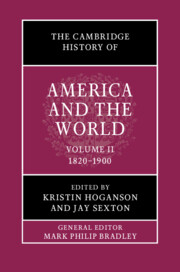Book contents
- The Cambridge History of America and the World
- The Cambridge History of America and the World
- The Cambridge History of America and the World
- Copyright page
- Contents
- Figures
- Maps
- Tables
- Contributors to Volume II
- General Introduction: What is America and the World?
- Introduction to Volume II
- Part I Building and Resisting US Empire
- Part II Imperial Structures
- Part III Americans and the World
- Part IV Americans in the World
- 23 The Changing Geography of Mobility, 1820–1940
- 24 The United States and the Greater Caribbean, 1763–1898
- 25 Borderlands and Border Crossings
- 26 The Liberal North Atlantic
- 27 “To Enter America from Africa and Africa from America” during the Nineteenth Century
- 28 Islamic World Encounters
- 29 The American Island Empire: US Expansionism in the Pacific and the Caribbean
- 30 Inter-Imperial Entanglements in the Age of Imperial Globalization
- Index
27 - “To Enter America from Africa and Africa from America” during the Nineteenth Century
from Part IV - Americans in the World
Published online by Cambridge University Press: 12 November 2021
- The Cambridge History of America and the World
- The Cambridge History of America and the World
- The Cambridge History of America and the World
- Copyright page
- Contents
- Figures
- Maps
- Tables
- Contributors to Volume II
- General Introduction: What is America and the World?
- Introduction to Volume II
- Part I Building and Resisting US Empire
- Part II Imperial Structures
- Part III Americans and the World
- Part IV Americans in the World
- 23 The Changing Geography of Mobility, 1820–1940
- 24 The United States and the Greater Caribbean, 1763–1898
- 25 Borderlands and Border Crossings
- 26 The Liberal North Atlantic
- 27 “To Enter America from Africa and Africa from America” during the Nineteenth Century
- 28 Islamic World Encounters
- 29 The American Island Empire: US Expansionism in the Pacific and the Caribbean
- 30 Inter-Imperial Entanglements in the Age of Imperial Globalization
- Index
Summary
On November 17, 1862, the New York Times reported that the transatlantic slave trade continued to flourish, arguing, “no commerce was ever more profitable than the traffic in Africans, provided those engaged could go on unmolested.”1 Even after the United States abolished the “African Trade” in 1807, slave trading across the Atlantic remained alluring to merchants unconvinced of the lucrativeness of “legitimate” trade with West and Central Africans. The Times tracked over 150 vessels that engaged in the slave trade from 1858 to 1861. Of that number, American authorities had seized thirty-six ships in US ports alone, primarily in the South. The commandeering of these ships exposed some American citizens’ complicity in perpetuating a trade then considered the shame of the “civilized” world. The Times detailed the circumstances under which officials impounded slave ships and arrested “Slavers” during the period preceding the Civil War.
- Type
- Chapter
- Information
- The Cambridge History of America and the World , pp. 642 - 668Publisher: Cambridge University PressPrint publication year: 2022



